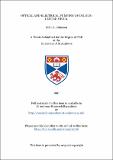Optical and electrical pumping of colour-centre media
Abstract
Within this thesis the exploitation of the large homogeneously broadened bandwidth of the LiF:F+2 colour-centre laser by production of frequency tunable ultrashort optical pulses over the 0.8-1.0mum spectral region has been presented. A synchronously pumped LiF:F+2 colour-centre laser produced pulses of 700fs duration with average powers of 30mW when a colliding-pulse-modelocked travelling-wave cavity was implemented. Passive modelocking of the LiF:F+2 colour-centre laser was achieved over two spectral operating regions centred around 860nm and 930nm when the saturable absorber dyes IR140 and DaQTeC were employed. Pulse durations as short as 180fs and 130fs were obtained at 860nm and 930nm respectively using colliding-pulse-modelocked group-velocity-dispersion compensated resonators. The laser was pumped at a 10% duty cycle throughout. The use of coupled-cavity- modelocking techniques combined with passive modelocking was found to extend both the tuning range of the laser and useful operating lifetime of the saturable dye. A home built NaCl:OH- colour-centre laser which encorporates the stabilised F+2 colour- centre is presented. Output powers of up to 450mW were obtained for input pump powers of 4W and the laser tuned from 1.4-1.8?m. Electroluminescence studies of NaCl, CsI, CsI:Na, CsI:Tl, and KI crystals are also presented in a study to assess the feasibility of obtaining laser action from such materials by electrical excitation. KI is shown to be the favoured laser candidate by this excitation method and evidence of temporal narrowing and signal enhancement of the electroluminescence output is presented.
Type
Thesis, PhD Doctor of Philosophy
Collections
Items in the St Andrews Research Repository are protected by copyright, with all rights reserved, unless otherwise indicated.

